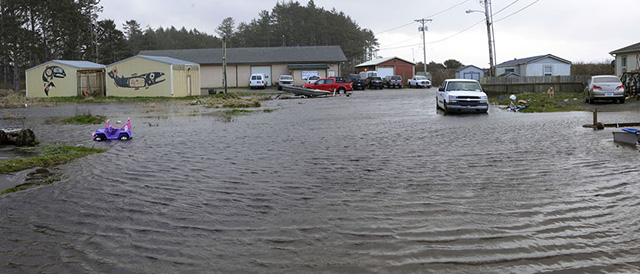
Fawn Sharp grew up in Taholah village, a small community on the Quinault Reservation nestled between the mouth of the Quinault River and the Pacific Ocean. She spent her childhood summers surrounded by water, splashing in Lake Quinault on the eastern edge of the reservation, and hiking along the local beaches near the village, scouring the rocks for starfish and other treasures. In the mornings, she was often up before the sun, out fishing with her grandparents on the river.
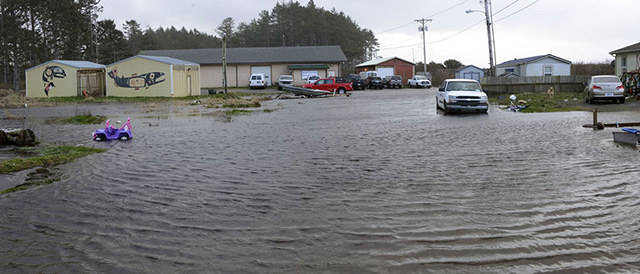 The Quinault have borne witness to the marked signs of climate change over the past century. In Taholah — which is home to some 825 people — these signs are becoming increasingly impossible to ignore. (Photo: Larry Workman)
The Quinault have borne witness to the marked signs of climate change over the past century. In Taholah — which is home to some 825 people — these signs are becoming increasingly impossible to ignore. (Photo: Larry Workman)
Decades after she left home for college, Sharp is back on the reservation, this time living near the lake, some 35 miles from her childhood home in Taholah. Now she goes by President Sharp, and leads both the Quinault Indian Nation and the Affiliated Tribes of Northwest Indians.
Since returning, Sharp has faced the kinds of tough issues that might have seemed outlandish, or even inconceivable, during her childhood. She’s seen the tribe’s salmon runs in sharp decline. She’s observed the rapid retreat of nearby glaciers. And she’s watched her childhood home, Taholah, endure dangerous flooding during increasingly harsh storm surges.
Given the growing threat that climate change poses to the “lower village,” as tribal members refer to the lower portion of Taholah, paired with ongoing concerns about the village’s vulnerability to earthquakes and tsunamis, Sharp and the Quinault leadership were forced to make an almost unthinkable decision: to leave home.
The Quinault have lived on the Olympic Peninsula for centuries, since long before the 1855 Quinault River Treaty established the Quinault Reservation and ceded vast tracts of lands to Washington State. The reservation is wedged between the towering mountains and dense temperate rainforest of Olympic National Park to the east and beaches and oceans to the west. It’s bisected by the swift Quinault River, and is home to black bear, Roosevelt elk, and bald eagles. The tribe’s ties to the land are strong. As it proudly claims on its website: “We are among the small number of Americans who can walk the same beaches, paddle the same waters, and hunt the same lands our ancestors did centuries ago.”
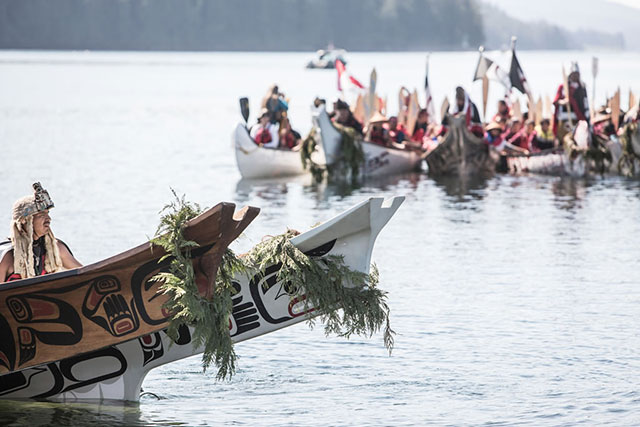 Traditional canoes arrive at Point Grenville, near Taholah, as part of an annual inter-tribal festival celebrating Native history, culture and tradition. For many tribes, losing home can also mean losing touch with vital cultural and spiritual practices. (Photo: Kris Krüg)
Traditional canoes arrive at Point Grenville, near Taholah, as part of an annual inter-tribal festival celebrating Native history, culture and tradition. For many tribes, losing home can also mean losing touch with vital cultural and spiritual practices. (Photo: Kris Krüg)
As is true in many Native communities around the world, the Quinault have borne witness to the marked signs of climate change over the past century. In Taholah — which is home to some 825 people — these signs are becoming increasingly impossible to ignore.
Globally, the twenty-first century has seen 16 of the hottest 17 years on record. In the Pacific Northwest, average air temperatures, which rose only 1.3 degrees Fahrenheit between 1895 and 2014, are expected to increase another 3 to 9 degrees Fahrenheit by 2100. Heavy rainfall events have increased in frequency, snowfall has decreased, and glaciers have pulled back, retreating deep into Washington’s mountains. The Anderson Glacier, for example, which historically fed the Quinault River, shrank by 90 percent between 1927 and 2009. And as overall precipitation decreases and glaciers shrink, stream flows are also declining.
Impacts extend to the coastline as well. According to moderate projections, ocean temperatures along Washington’s Pacific coast are predicted to increase by 2 degrees Fahrenheit by the 2040s. Sea level rise, influenced by a range of factors — including warming water temperatures and melting ice sheets — is difficult to predict, but NOAA’s latest report, released in January, projects that the world’s oceans will rise between one and eight feet by 2100, a significant increase above previous estimates, which will lead to more frequent and stronger high tides and storm surges.
These projections are more than just numbers for tribes in the Pacific Northwest. A November 2016 report from the 20 member tribes of the Northwest Indian Fisheries Commission lays out the extraordinary implications climate change has for Native communities. For these peoples, whose cultures and livelihoods developed around water and marine resources, a warmer future means declining fish runs, shrinking shellfish populations, loss of water supplies, and loss of opportunity to participate in traditional cultural activities, not to mention the disappearance of the land they have lived on for generations. As they note in the report: “Virtually all of the resources and activities that our treaties protect — fishing, gathering, and hunting — are impacted by the effects of climate change.”
Taholah has already gotten a glimpse of this warmer future and the threats it poses to tribal culture, resources, and well-being. The signs of climate change became apparent on the reservation at least a decade ago when the Quinault River’s endemic blueback salmon runs declined sharply to a fraction of their historical numbers. The shrinking population could be traced in large part to the loss of the Anderson Glacier, which resulted in lower and warmer stream flows and more sediment in the river. A lack of blueback (a type of sockeye) meant a depleted source of both food and income for the tribe.
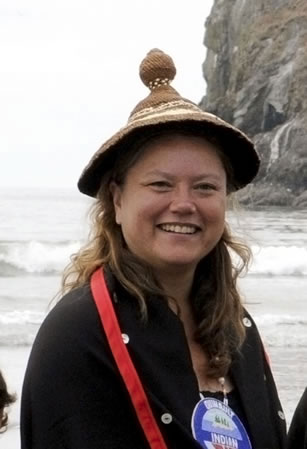 Fawn Sharp, president of the Quinault Indian Nation, is helping the tribe navigate the challenging process of relocating lower Taholah. (Photo: Larry Workman)This devastating reality spurred the tribe to take action to protect the salmon. “We undertook the first phases of the blueback restoration efforts back in 2006 and 2007 around trying to preserve our sockeye,” says Sharp. Not long after, the “Quinault Nation started to adopt various climate change polices in order to contend with a declining species that is central to our culture and identity as Quinault people.”
Fawn Sharp, president of the Quinault Indian Nation, is helping the tribe navigate the challenging process of relocating lower Taholah. (Photo: Larry Workman)This devastating reality spurred the tribe to take action to protect the salmon. “We undertook the first phases of the blueback restoration efforts back in 2006 and 2007 around trying to preserve our sockeye,” says Sharp. Not long after, the “Quinault Nation started to adopt various climate change polices in order to contend with a declining species that is central to our culture and identity as Quinault people.”
Shortly after that, Sharp was forced to declare multiple states of emergencies in the village because of increasingly frequent flooding of the lower portion of Taholah. One of these emergencies occurred in 2014 when waves breached the village’s three-meter-high seawall, constructed in the 1970s. The Army Corps of Engineers partnered with the tribe to help rebuild the wall later that year, but flooding concerns emerged again in 2015 and the village was partially evacuated.
As Sharp puts it, “The Quinault Nation has become the front line — ground zero if you will — in dealing with climate change.” And though the tribe had already begun considering relocation years earlier, the 2014 flood was a final straw of sorts, after which the Quinault hired a team to help manage the village’s move to higher ground.
Though Native communities have themselves done very little to contribute to the causes of climate change, worldwide they are among those impacted first and worst by global warming. They are also often uniquely positioned to recognize the early signs of changing environmental patterns and weather given their proximity to, and deep connections with, the lands they live on.
“You’re talking about communities that have been in place for generations, and live off the land and the waters, and they are seeing and experiencing the changes first and foremost,” says Julie Maldonado, an environmental studies lecturer at University of California, Santa Barbara who specializes in environmental vulnerability and displacement of Indigenous peoples. “That relationship that they have, that long-term monitoring process, and that long-term knowledge they have of a place … they can see and understand and experience what is going on.”
It should, therefore, come as no surprise that Taholah isn’t the only Native community taking a proactive stance in the face of inevitable climate changes. In the Pacific Northwest alone, several other tribes are mounting relocation efforts, and many more are developing climate adaptation plans to build resiliency and prepare for rising temperatures on their reservations.
The Hoh, who have a small reservation north of the Quinault on the Olympic Peninsula, the arm that juts out of the northwest corner of Washington State, have struggled with increasingly frequent flooding as well as loss of land to erosion. They are in the early stages of moving their tribal village, which is home to about 130 people. The Quileute, located even farther north up the Peninsula, are also at risk from rising sea levels, and are also planning a move. Farther inland, the Sauk-Suiattle tribe, whose housing and infrastructure along the Sauk River is vulnerable to erosion and flooding, are, too, in the early stages of relocation planning.
Native communities beyond the Pacific Northwest, some of which face even more urgent climate dangers, are undertaking similar efforts. In Alaska, which is warming two to three times faster than the lower 50 states, the Army Corps of Engineers and Government Accountability Office have identified at least 31 villages facing imminent risk from climate change due to coastline erosion or flooding. So far, three Native communities — Kivalina, Shishmaref, and Newtok — have voted to move. In Louisiana, one of the US states most vulnerable to rising sea levels, the Isle de Jean Charles band of Biloxi-Chitimacha-Choctaw plans to resettle farther inland. The community of about 60 people, which has lost roughly 98 percent of its lands since the 1950s, is the first Native community to receive federal funds to move.
Many other Native communities are adapting in place, at least for now. The University of Oregon’s collaborative Tribal Climate Change Project lists nearly 30 tribes that have adopted climate adaptation plans of some sort. The majority of these are tribes are in the Pacific Northwest and Alaska — 8 and 14 respectively — but the effort extends across the continent.
Historical loss of land places practical limitations on where tribes can move to get out of harm’s way.
The Red Lake Band of Chippewa in Minnesota, for example, have an adaptation plan emphasizing protection of water and forest resources. The Navajo Nation — which reaches into Arizona, New Mexico, and Utah — has conducted a vulnerability assessment of important wildlife and plant species that will provide a foundation for future adaptation work. And the Confederated Salish and Kootenai tribes in present-day Montana have developed a preliminary climate adaptation plan that integrates traditional knowledge and prioritizes cultural interests.
Moving an entire community is a monumental undertaking, riddled with complicated decisions and institutional barriers. To start, there’s the issue of where to move. Ninety percent of the Hoh reservation is in a flood zone, and both Hoh and Quinault lands are especially vulnerable to earthquakes and tsunamis. Historically, the Quinault were semi-nomadic — they used to have villages up and down the Quinault River and would move between them as necessary for hunting, gathering, and safety. With the colonization of North America, however, Native people were forced into much smaller areas, and “given” reservations on a fraction of their historical territory. This loss of land has not only compromised many of their cultural and spiritual practices, it now also places very practical limitations on where tribes can move to get out of harm’s way.
Because land within reservation boundaries may not offer safe or desirable alternatives for relocation, tribes often must acquire new land. That is no small task, though several tribes in the Pacific Northwest have done so. The Quinault have acquired 120 acres adjacent to their current reservation, and a land exchange for an additional 80 acres is currently making its way through the US Bureau of Indian Affairs. The Sauk-Suiattle bought land about eight miles from their reservation, also with relocation in mind, and the Quileute tribe has been transferred 785 acres within Olympic National Park, land that it had ceded to the federal government in 1855.
The Hoh, too, have purchased several parcels of land to the east of their reservation from timber and railroad companies. The tribe has not, however, made big strides on relocation work since then, and according to Melvinjohn Ashue, vice chairman of the Hoh Tribal Council, there’s a relatively straightforward reason for the delay: lack of funds.
Talk to any of the tribes, or to the academics and allies working with them about the challenges of adaptation planning and they are likely to put money at the top of the list. Relocation carries a steep price tag — the Quinault tribe estimates that their move could cost as much as $400 million when all is said and done. Yet, “There is no federal program to support tribal relocations,” Maldonado says, “or for that matter, other community relocations, and Native communities are among the poorest in the country.”
That’s not to say there’s no funding — limited federal funds have been made available for relocation planning. The Isle de Jean Charles band of Biloxi-Chitimacha-Choctaw made headlines last year when the tribe was awarded $48 million from the Department of Housing and Urban Development for their inland resettlement. This award, however, was a one-time grant, made as part of HUD’s $1 billion Natural Disaster Resiliency Competition, to a tribe that has already faced especially extreme land loss.
In general, funding for these efforts is ad hoc, and tribes must apply for assistance through various government programs. The US Environmental Protection Agency, for example, offers Tribal General Assistance Program Grants, which can be used to develop climate change adaptation plans. The Quinault have used funds from a Social and Economic Strategies grant from the Administration for Native Americans to hire three planners to coordinate their relocation effort. And the Army Corp of Engineers has several different programs through which it can work with tribes. All of these partnership mechanisms, however, require some type of cost-share agreement.
“A lot of times tribes don’t have the resources to be able to partner with us,” explains Lori Morris, tribal liaison with the US Army Corps’ Seattle District, which is currently working with both the Quileute and Hoh tribes. “So we have to be kind of creative in how we get their cost-share paid for and assist them with that.”
Other Native communities have been forced to think outside the box. In 2008, Kivalina, a small Native village of Inupiat Inuit that scientists estimate could be underwater by 2025, sued 22 energy companies for $400 million to help with a relocation effort, arguing they were responsible for the impacts of climate change. The village lost its final appeal for the case in 2012. More recently, in early January, Newtok — another tiny community in western Alaska — asked the federal government to declare climate impacts in the region, which include erosion and melting permafrost, as an official disaster. The tribe has selected a site for a new village nine miles away, and such a declaration would unlock federal funds for the relocation. The request was a long-shot from the beginning. Now, with Donald Trump in the Oval Office, it seems even less likely to be granted.
Funding challenges aside, there are also essential cultural issues to consider. Maldonado points out that community relocation efforts are “not just about moving a house from X to Y.” Rather, it’s crucial that tribes, particularly when they decide to move their entire community, are able to choose a safe location that is close enough to their original home that they can still access their natural and cultural resources and sites of cultural importance. They also “need to be able to maintain their community structure as it makes sense to them,” she adds.
Maintaining proximity can help communities cope with the trauma of displacement. In the case of the Quinault and the Hoh, the tribes expect to remain close to their ancestral land. The Quinault plan to maintain their old reservation land, which will be connected to the new village, for recreational activities and wildlife habitat, among other things, and while the land purchased by the Hoh is not adjacent to their reservation, the tribe also acquired 37 additional acres of National Park Service land that would connect the current village with the new one. But both Kivalina and Shishmaref in Alaska have struggled to find suitable relocation sites.
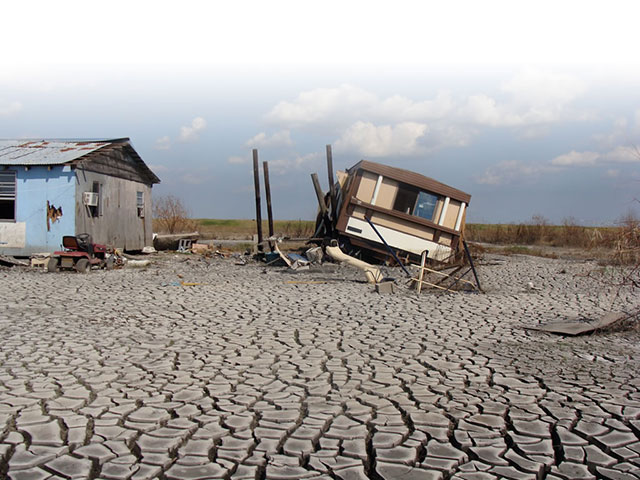 In Louisiana, the Isle de Jean Charles band of Biloxi-Chitimacha-Choctaw have lost roughly 98 percent of their land to erosion, flooding, and shifting soil from oil and gas development. Last year, the federal government awarded the tribe $48 million to relocate. (Photo: Karen Apricot)
In Louisiana, the Isle de Jean Charles band of Biloxi-Chitimacha-Choctaw have lost roughly 98 percent of their land to erosion, flooding, and shifting soil from oil and gas development. Last year, the federal government awarded the tribe $48 million to relocate. (Photo: Karen Apricot)
Even when proximity is maintained, community relocation is not without a sense of loss. Melvinjohn Ashue spent his early years on the Hoh reservation in a trailer right along the beach. Now, Ashue says, much of the lower village has been abandoned, and the ocean has taken much of the landmass and more than a few trees. “Growing up [in the lower village,] it’s one of my favorite places,” he says. “All my family was there. We all lived down on the lower Hoh [River]. But since things have been changing down there, there are no homes. No one lives in the lower village right down by the beach.”
Ashue also expects that, if the Hoh relocate, daily reminders of Hoh culture and traditions will be absent in the new community. For example, many of the houses in the lower village have carving sheds attached, which were used to carve traditional canoes. These days, few of these sheds are put to good use — the younger generation has few carvers — and it’s likely that new homes will omit them. Ashue also regrets that environmental change on the Hoh lands has meant that he hasn’t been able to participate in some of the activities that his parents and grandparents engaged in. “They used to do drift netting when they walked along the banks,” he says. “Well, there are no more banks to walk along. Not being able to do that is kind of a bummer.”
Seeing these changes over the course of his lifetime has been eye opening for Ashue. “I wish we could share and show everybody else, This is what it used to look like, and this is what it looks like now.”
Atle Solberg cautions against estimating the scale of future climate-induced displacement. Head of the coordination unit of the Platform on Disaster Displacement, an intergovernmental group working to protect people displaced by disasters linked to natural hazards, he says there are simply too many variables at play. Still, the few estimates that are available are startling. The United Nations University Institute for the Environment and Human Security and the International Organization for Migration estimate that climate change could displace anywhere between 50 million and 200 million people by 2050.
A major driver of this displacement will be sea level rise. Indeed, island nations like the Maldives and Kiribati have been raising the alarm about rising oceans for years, and have been forced to consider the prospect of moving entire countries.
In the United States, where more than half of the population lives within 50 miles of the coast, researchers estimate that some 13 million people could be displaced by 2100 from coastal flooding alone, the majority in the southeast. Then there’s desertification, melting glaciers, and droughts, all of which are projected to contribute to the displacement problem.
Unfortunately, despite the scale of the issue, there is an alarming lack of guidelines or regulatory structure for climate-induced relocations, or for community relocations in general.
So-called “climate refugees” are not, for example, considered refugees under international law, which limits the definition of refugees to those crossing international borders to flee war or persecution. Climate-related migration did receive mention in the Paris Agreement, and per a decision by the Conference of the Parties, there is now a nascent task force on climate displacement under the Warsaw International Mechanism on Loss and Damage. But overall, “international law is very quiet on this issue [of displacement] with respect to climate change and weather,” Solberg says. “There is almost nothing that guides or orients in that situation.”
Like most international initiatives, assistance programs in the US also tend to focus on disaster response and recovery — think FEMA relief after Hurricane Sandy — rather than preparation and prevention, and are decidedly focused on the individual, rather than the community.
Robin Bronen, executive director of the Alaska Institute for Justice, who has been working with Native communities in Alaska on relocation issues for the past decade, is trying to fix that. With funding from NOAA and the National Science foundation, Bronen is working with 15 Native Alaskan tribes to design a human-rights based community relocation framework that will fill this gap for Native people in the Arctic.
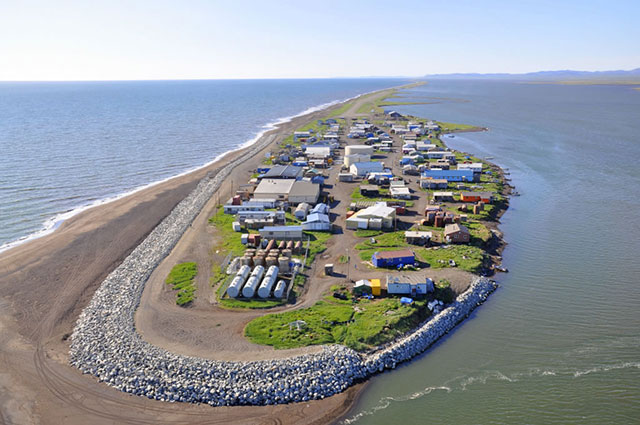 In the Alaskan village of Kivalina, climate change is contributing to flooding, erosion, and increasingly intense storms. Warming temperatures are also delaying the seasonal formation of sea ice, which the village has traditionally relied on for protection from winter storm surges. (Photo: Shorezone / Flickr)
In the Alaskan village of Kivalina, climate change is contributing to flooding, erosion, and increasingly intense storms. Warming temperatures are also delaying the seasonal formation of sea ice, which the village has traditionally relied on for protection from winter storm surges. (Photo: Shorezone / Flickr)
“One of the critical components to creating this relocation institutional framework is to design a community-based monitoring and assessment tool with state and federal government agencies,” Bronen says.
Such a tool would help ensure that, before disaster strikes, people are able to determine whether relocation is necessary, and when. Bronen expects the model will be replicable in service of communities across the world. That’s a tall order. “We are creating something that doesn’t exist anywhere in the world, so it’s just really hard,” she says.
Monitoring and relocation guidelines for Native communities on the frontlines of the climate crisis could also help avoid what Bronen calls “the biggest concern,” namely, the pitfalls of past relocation efforts. She points to the forced relocation of the Unangan from villages in the Aleutian Islands during World War II, during which 10 percent of the population died, as an example of “the track record we have when human rights aren’t included and governments make decisions to relocate.”
Solberg echoes these concerns. “Planned relocation processes haven’t really been successful in the past,” he says. “There is always an element of loss that people feel, whether it is non-economic loss or economic loss in the sense that the economic situation has deteriorated after the move.”
Solberg uses the example of fishing villages that were relocated in countries like Indonesia and Sri Lanka following the 2004 Indian Ocean tsunami. “You cannot move fisherman inland without having a very good plan about how they are going to access their livelihood,” he says. Several villages that were built for relocations following the tsunami are now empty because planning was insufficient, and because people didn’t want to move, he says.
For all of these reasons, relocation is always a measure of last resort, considered only after, as Maldonado puts it, “everything else has been pursued, after all other options to stay in place” have been exhausted.
Staying in place requires figuring how to adapt and build climate resilient communities. Countries like the Netherlands, which are vulnerable to flooding, owe their existence in large part to the use of dikes, canals, and water pumps, for example. Across the United States, cities from New York to San Francisco have begun to consider similar measures. But these options are usually expensive, require constant maintenance, and aren’t necessarily foolproof.
Back in Taholah, the Quinault have worked hard to design a relocation plan that reflects the nation’s culture and way of life. The tribe has prioritized moving seniors and families with children, for example, and the planning team is already designing a 30,000 square-foot “generations building” that will house the senior program, the head start program, early head start, and day care.
Relocation is always a measure of last resort.
The tribe began clearing land for the first 50 lots in the new village in December 2016, and Charles Warsinske, senior planner for the nation, expects that the master plan for the town will be done by early April of this year. Still, he says, “If we maintain our momentum,” it will be 15 years before the majority of people who want to move do so.
President Sharp is clear that even as relocation efforts progress, no one in lower Taholah village will be forced to move. “We will do our best to provide information about the situation, but we will respect citizens’ rights to live where the Creator put them — the lands that were given to our ancestors,” she has said.
Kathy Rosenmeyer is among those who might chose to stay. She bought her house in the lower village in 1997 close to where her ancestors used to have homes, and her daughter now lives next door. Rosenmeyer acknowledges that the lower village has changed in the time she’s lived there. Homes have been torn down — homes that the tribe has chosen not to replace — and it’s beginning to feel like fewer and fewer people live in the community. Still, she is hesitant to leave, in part because she’s paid 20 years on a 30-year loan and is uncertain about how the transition will work.
Her indecision also reflects her love for where she lives. Her home is close the beach, where she walks her dogs, and she can hear the ocean from it. “I guess it’s human nature to get attached to the homes that you buy,” she adds. “So I’m actually not really considering moving out of there.”
For others in Taholah, however, the decision to move is made with a view to the future. The promise of a new village on higher ground offers hope and opportunity — a chance to keep the community together and for the tribe to proactively move out of harm’s way on its own terms.
“While there is somewhat a sense of loss and closing that chapter in the lower village, there’s also opening a new chapter of hope, and envisioning an entirely new village,” says Sharp. “And that’s been an exciting part of the process, engaging in a national visioning exercise with our citizens [about] the future that we all see, our collective future.”
Our most important fundraising appeal of the year
December is the most critical time of year for Truthout, because our nonprofit news is funded almost entirely by individual donations from readers like you. So before you navigate away, we ask that you take just a second to support Truthout with a tax-deductible donation.
This year is a little different. We are up against a far-reaching, wide-scale attack on press freedom coming from the Trump administration. 2025 was a year of frightening censorship, news industry corporate consolidation, and worsening financial conditions for progressive nonprofits across the board.
We can only resist Trump’s agenda by cultivating a strong base of support. The right-wing mediasphere is funded comfortably by billionaire owners and venture capitalist philanthropists. At Truthout, we have you.
We’ve set an ambitious target for our year-end campaign — a goal of $119,000 to keep up our fight against authoritarianism in 2026. Please take a meaningful action in this fight: make a one-time or monthly donation to Truthout before December 31. If you have the means, please dig deep.